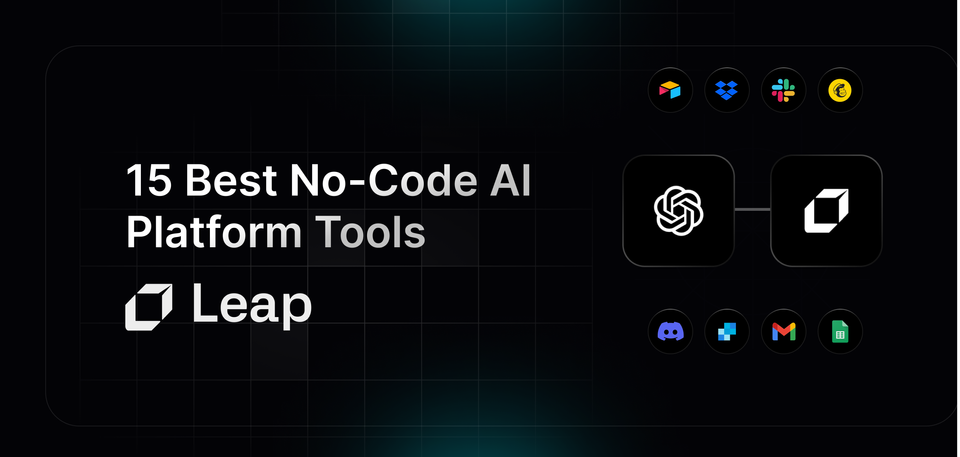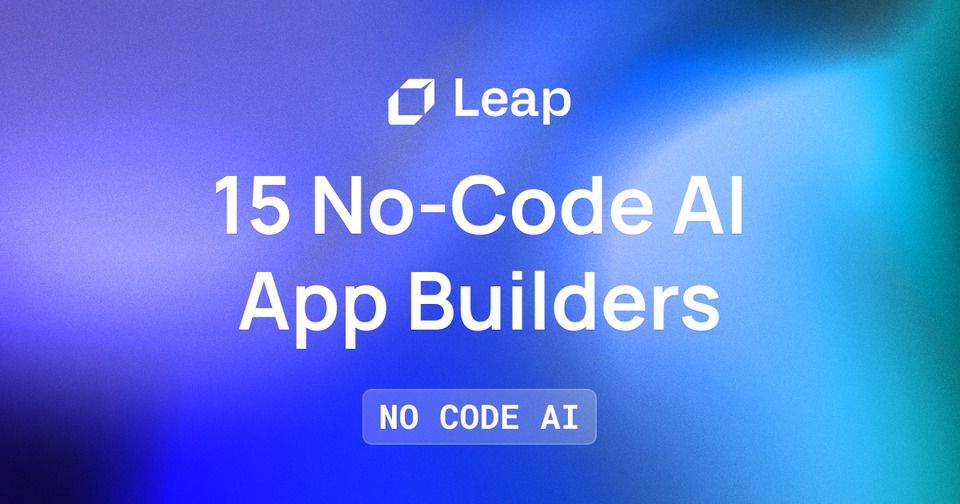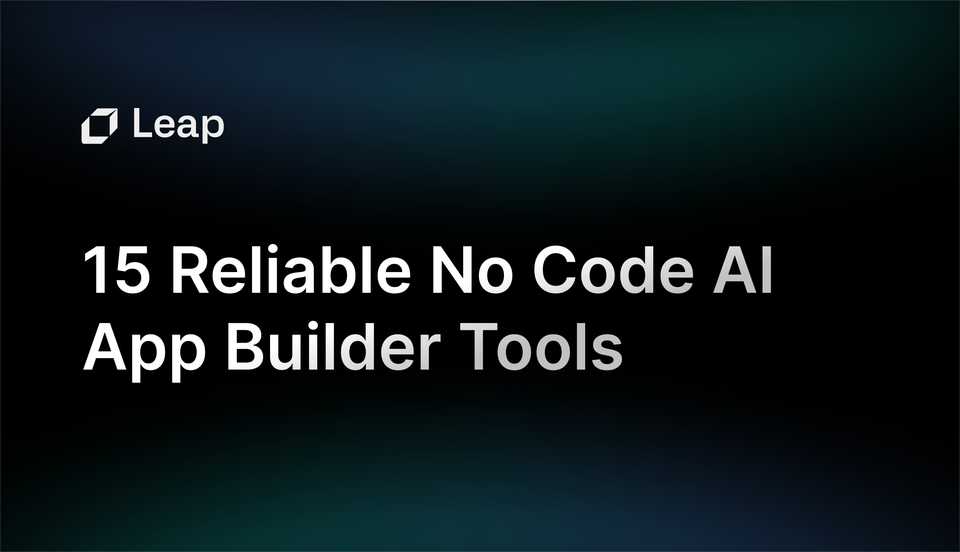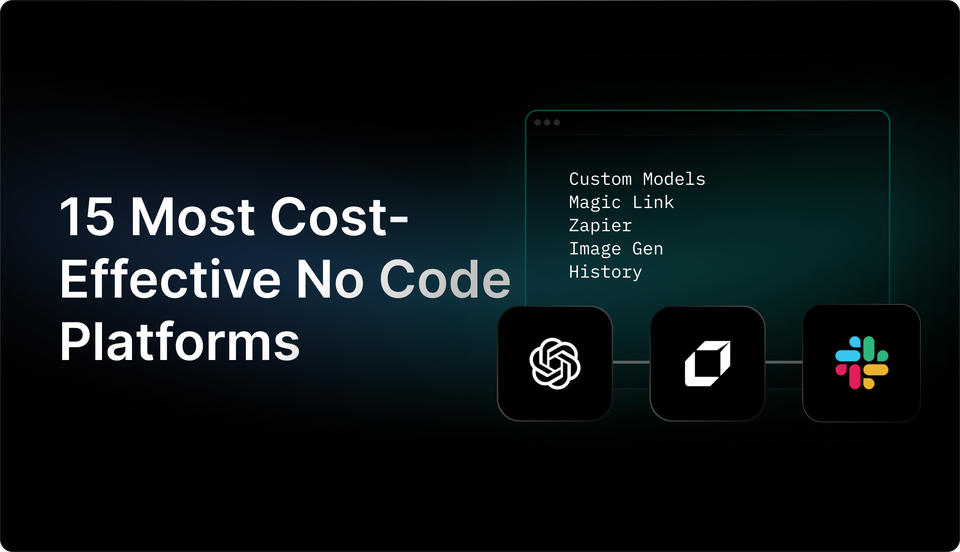Complete Guide On Building An AI Workflow & Free AI Workflows Tool
Optimize efficiency with seamless ai workflow management. Streamline processes and boost productivity with intelligent automation solutions.
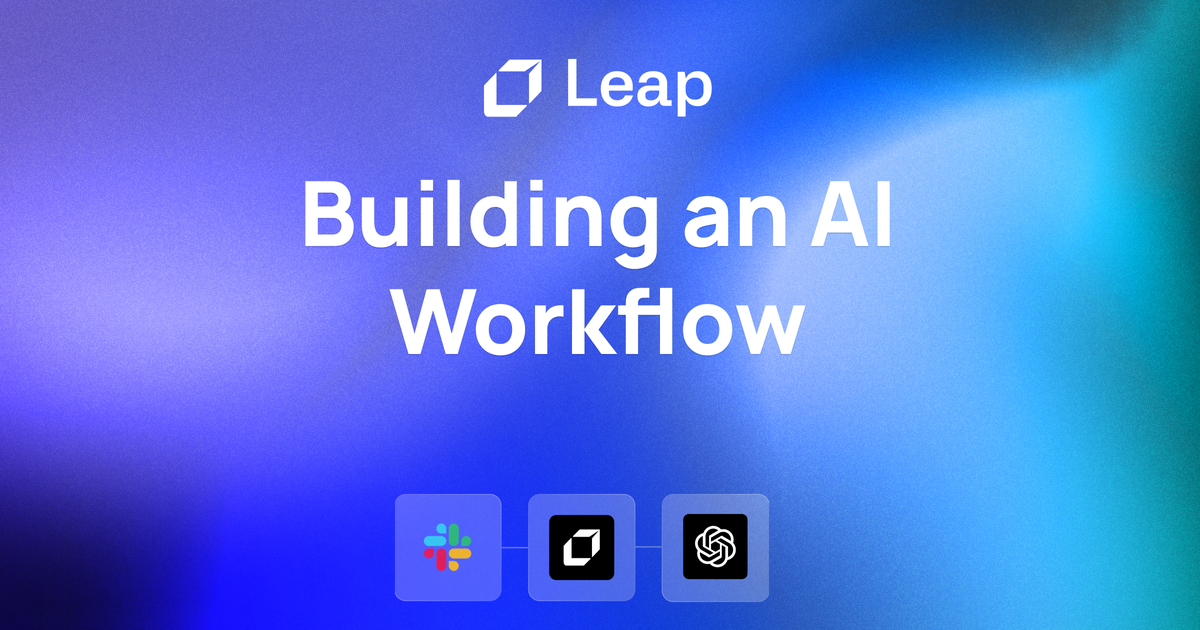
In the ever-evolving world of technology, the integration of artificial intelligence has taken center stage, revolutionizing industries across the board. From healthcare to finance, AI has reshaped the way we work, and its potential seems limitless. Harnessing the power of AI requires an efficient and streamlined process, which is where the concept of AI workflow comes into play. An AI workflow is the intricate dance between human and machine, a choreography of data analysis, model training, and decision-making.
By understanding the intricacies of AI workflow, we can unlock the true potential of AI, empowering businesses to make data-driven decisions and embrace the future of automation. Whether you're a seasoned AI enthusiast or just dipping your toes into the world of no code AI, this blog will dive into the depths of AI workflow, exploring its components, best practices, and the impact it has on our everyday lives. So, let's embark on this journey together and unravel the mysteries of AI workflow.
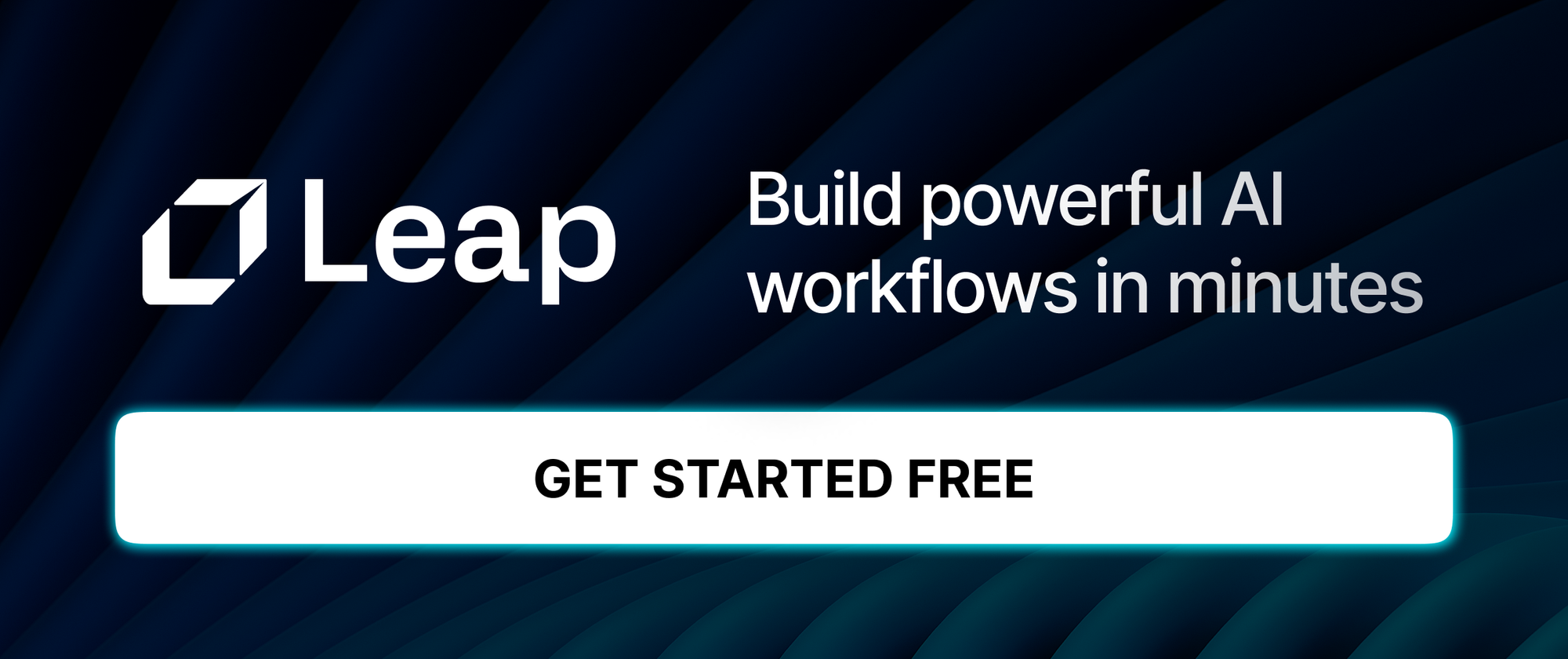
What Is An AI Workflow?

Artificial intelligence (AI) is revolutionizing numerous industries by automating tasks that were previously handled by humans. At the heart of this transformative power lies the concept of an AI workflow. An AI workflow is a structured and systematic process that enables the efficient execution of complex tasks through the power of automation and advanced algorithms. By leveraging AI workflow, businesses can optimize their operations, improve productivity, and achieve unprecedented levels of accuracy.
Understanding the AI Workflow: A Sequence of Intelligent Actions
An AI workflow is like a symphony, composed of various interconnected components that work in harmony to achieve a desired outcome. It encompasses a sequence of intelligent actions, meticulously designed to address specific requirements and objectives. These actions can include data ingestion, preprocessing, feature engineering, model training, evaluation, deployment, and monitoring.
Data Ingestion: Feeding the AI Engine
The AI workflow commences with data ingestion, where relevant data from multiple sources is collected and assimilated. This may involve structured or unstructured data, such as text, images, or numerical values. In this section, data is cleansed, transformed, and prepared for the subsequent stages of the workflow.
Preprocessing: Refining the Raw Material
Once the data is ingested, the preprocessing stage follows, where the data is refined and prepared for analysis. This involves tasks such as data normalization, feature extraction, and handling missing values. By ensuring data quality and consistency, preprocessing lays the foundation for accurate and reliable AI models.
Feature Engineering: Unleashing the Power of Data
Feature engineering is an essential step in the AI workflow, where the raw data is transformed into meaningful features that can be utilized by the AI models. This involves selecting, combining, and creating relevant features that capture the underlying patterns and relationships within the data. Effective feature engineering allows AI models to make more accurate predictions and classifications.
Model Training: Enabling Intelligent Decision-Making
Model training is the heart of the AI workflow, where the AI algorithms learn from the prepared data to make intelligent decisions. This involves selecting and training appropriate AI models, such as deep learning neural networks or decision trees, using a variety of techniques like supervised or unsupervised learning. The model is exposed to the training data, and through iterations, it learns to recognize patterns and make accurate predictions.
Evaluation: Assessing Performance and Fine-Tuning
Once the model is trained, it needs to be evaluated to assess its performance and ensure its effectiveness. This evaluation involves testing the model on a separate dataset, known as the validation set, and measuring various performance metrics such as accuracy, precision, recall, and F1 score. If the model falls short of expectations, iterative fine-tuning is performed to enhance its performance.
Deployment: Unleashing the Power of AI
After successful evaluation, the AI model is ready for deployment, where it is integrated into the existing infrastructure or system. This enables the model to make predictions or perform automated tasks in real-time, contributing to enhanced operational efficiency. During deployment, considerations such as scalability, security, and user experience are addressed to ensure a seamless integration into the workflow.
Monitoring: Ensuring Continual Optimization
The AI workflow doesn't end with deployment; it enters the monitoring phase. Here, the deployed model is continuously monitored to assess its performance, detect any anomalies, and recalibrate if necessary. This iterative process ensures that the AI model remains accurate, reliable, and up-to-date, adapting to changing circumstances and maintaining its effectiveness over time.
The AI workflow provides a structured framework for organizations to harness the potential of automation and AI algorithms. By following a well-defined sequence of actions, businesses can streamline their operations, enhance efficiency, and unlock new realms of productivity. As AI continues to evolve, the AI workflow will undoubtedly play a pivotal role in shaping the future of countless industries, enabling them to embrace the transformative power of intelligent automation.
Related Reading

How An AI Workflow Can Drastically Improve Your Business

Businesses are constantly seeking innovative solutions to streamline their operations and gain a competitive edge. One such solution that has garnered significant attention is the implementation of an AI workflow. An AI workflow refers to the integration of artificial intelligence technologies into the existing business processes to automate tasks and enhance efficiency. Let's explore how an AI workflow can drastically improve a business across various aspects, including marketing and beyond.
Automating Marketing Processes
Marketing is a critical component of any business, and an AI workflow can revolutionize this domain by automating various marketing processes. AI-powered tools can analyze large volumes of customer data, allowing businesses to gain valuable insights into consumer behavior and preferences. These insights enable businesses to develop highly targeted and personalized marketing campaigns that resonate with their target audience, leading to increased customer engagement and conversion rates.
AI algorithms can automate the creation and distribution of marketing content. By leveraging natural language processing and machine learning, businesses can generate compelling content tailored to specific customer segments, saving time and resources. AI-powered chatbots and virtual assistants can also provide instant customer support, enhancing the overall customer experience and fostering brand loyalty.
Enhancing Operational Efficiency
In addition to marketing, an AI workflow can significantly improve operational efficiency in various departments. By automating repetitive and time-consuming tasks, businesses can free up valuable resources and enable employees to focus on more strategic and creative endeavors. For instance, AI algorithms can automate data entry, analysis, and reporting, reducing human error and accelerating decision-making processes.
AI-powered predictive analytics can optimize inventory management by forecasting demand patterns and identifying potential supply chain disruptions. By ensuring optimal stock levels and minimizing wastage, businesses can enhance their bottom line and customer satisfaction simultaneously.
Improving Customer Relationship Management
With an AI workflow, businesses can also improve their customer relationship management processes. AI algorithms can analyze vast amounts of customer data, including purchase history, browsing behavior, and social media interactions, to generate comprehensive customer profiles. These profiles enable businesses to personalize their interactions with customers and tailor their products and services accordingly.
AI-powered recommendation engines can suggest relevant products and services to customers based on their preferences and purchase history. This not only enhances the customer experience but also increases cross-selling and up-selling opportunities. AI algorithms can proactively identify and address customer issues and complaints, thereby improving customer satisfaction and loyalty.
Driving Innovation and Decision-Making
An AI workflow can foster innovation and drive better decision-making within a business. By leveraging machine learning algorithms, businesses can analyze market trends, competitor behavior, and customer feedback to identify new opportunities and optimize business strategies. AI-powered algorithms can also simulate various scenarios and predict potential outcomes, allowing businesses to make informed decisions and mitigate risks.
AI can facilitate collaboration and knowledge sharing within an organization. By automating document management and leveraging natural language processing, businesses can extract valuable insights from unstructured data and enhance information accessibility across departments. This promotes innovation and enables employees to make data-driven decisions, driving the overall growth and success of the business.
Integrating an AI workflow into a business can have a transformative impact across various aspects. From automating marketing processes and enhancing operational efficiency to improving customer relationship management and driving innovation, AI technologies can revolutionize the way businesses operate. By embracing this technological advancement, businesses can stay ahead of the competition, deliver exceptional customer experiences, and achieve sustainable growth.
How To Scale AI Workflows To Changing Business Needs

The ability to scale and adapt AI workflows is crucial for staying competitive. As business needs evolve and technology advances, organizations must be agile in their approach to AI implementation. Here are some key strategies to scale and adapt AI workflows to meet changing business needs:
1. Flexible Infrastructure
To accommodate changing business needs, it is important to have a flexible infrastructure that can seamlessly integrate AI workflows. Cloud-based platforms like Leap provide the scalability and agility required to adapt AI workflows as business demands shift. With Leap, you can easily create and customize AI automation without the need for complex coding or infrastructure changes.
2. Agile Development Processes
Agile development methodologies, such as Scrum or Kanban, can be applied to AI workflow development. These methodologies prioritize collaboration, iterative development, and continuous improvement. By adopting an agile approach, organizations can quickly respond to changing business needs and make necessary adjustments to their AI workflows.
3. Continuous Monitoring and Optimization
AI workflows should be continuously monitored and optimized to ensure they are delivering the desired outcomes. By leveraging data analytics and performance metrics, organizations can identify bottlenecks or areas for improvement in their AI workflows. This allows for timely adjustments and enhancements to keep pace with changing business needs.
4. Collaboration and Knowledge Sharing
Collaboration between business stakeholders, data scientists, and AI experts is essential for scaling and adapting AI workflows. By fostering a culture of knowledge sharing and cross-functional collaboration, organizations can leverage diverse perspectives and insights to optimize AI workflows and align them with evolving business needs.
5. AI Workflows as a Service
Partnering with AI workflow platforms, like Leap, can provide organizations with access to pre-built AI models and integrations, easing the burden of developing and maintaining AI workflows in-house. Leap offers a wide range of best-in-class AI models and seamless integrations with popular tools, enabling organizations to quickly scale and adapt their AI workflows without extensive time and resource investment.
Scaling and adapting AI workflows to changing business needs requires a combination of technological agility, collaborative culture, and continuous optimization. By leveraging flexible infrastructure, adopting agile development processes, continuously monitoring and optimizing workflows, fostering collaboration, and partnering with AI workflow platforms like Leap, organizations can effectively scale and adapt their AI capabilities to meet the evolving demands of the business landscape.
AI Workflows: Supercharge Your Work with Leap
Leap helps you to automate your work with the power of AI. Partnered with Zapier, Vercel, and more, Leap enables you to supercharge your work by allowing you to create custom AI automations. Create sophisticated AI automations with no-code. Connect the tools you love with best-in-class AI text, image, and audio models. Supercharge your existing tools with seamless AI integrations to OpenAI, Microsoft, and more.
From summarizing documents, to voice translation, to AI call transcription, to AI avatar and asset generation, to SEO automation, automate anything with Leap Workflows. The opportunities for automation are endless with Leap workflows. Try Leap's AI Workflows tool for free today.
Related Reading
- Artificial Intelligence In Business
- Process Vs Workflow
- Ai For Small Business
- Ai Workflow Automation
- Ai Automation Tools
- No-code Workflows
Best Practices for Designing and Implementing AI Workflows

Designing and implementing AI workflows for a business can be a complex task, but there are some best practices that can help ensure success. By following these guidelines, businesses can maximize the benefits of AI and streamline their processes.
1. Define clear objectives and goals
Before designing an AI workflow, it is crucial to clearly define the objectives and goals of the automation. This will help determine the specific tasks that need to be automated and the desired outcomes. By having a clear focus, businesses can avoid wasting time and resources on unnecessary processes.
2. Identify the right AI tools and technologies
There are various AI tools and technologies available in the market, each with its own strengths and limitations. It is important to carefully evaluate and select the tools that align with the business requirements. Consider factors such as accuracy, scalability, ease of integration, and ongoing support.
3. Collect and prepare high-quality data
AI workflows heavily rely on data, and the quality of the data directly impacts the accuracy and effectiveness of the models and algorithms. It is essential to collect relevant and representative data and ensure it is clean, consistent, and properly labeled. Data preparation techniques such as cleaning, normalization, and feature engineering are crucial for achieving accurate and meaningful results.
4. Iterative development and testing
AI workflows should be developed iteratively, allowing for continuous improvement and refinement. Start with a minimum viable product and gradually add more complexity as the workflow matures. Regular testing and evaluation are essential to identify and address any issues or limitations. Collect feedback from users and make necessary adjustments to enhance the workflow's performance.
5. Ensure data privacy and security
AI workflows often involve handling sensitive data, so it is important to prioritize data privacy and security. Implement robust security measures to protect data from unauthorized access or breaches. Comply with relevant regulations, such as GDPR or HIPAA, to ensure legal and ethical handling of data.
6. Provide user-friendly interfaces
AI workflows should be designed with user-friendliness in mind. Provide intuitive interfaces that are easy to navigate and understand. Users should be able to interact with the workflow without requiring extensive technical knowledge. This will encourage adoption and usage among employees, leading to increased productivity and efficiency.
By following these best practices, businesses can design and implement AI workflows that optimize their processes and drive meaningful results. Leap, with its powerful AI automation capabilities, can be a valuable tool in this journey. With Leap Workflows, businesses can create custom AI automations, connecting their favorite tools with best-in-class AI models to supercharge their work. Try Leap's AI Workflows tool for free today and unlock the endless opportunities for automation.
Create Game Changing Automations Today With Leap’s AI Workflows
Automating workflows with the power of AI can revolutionize the way we work. With Leap Workflows, you can tap into the potential of artificial intelligence to streamline and optimize your daily tasks. So, let's dive into the world of AI workflows and discover how Leap can help you supercharge your work.
Automate Anything with Leap Workflows
AI workflows are all about automating tasks and processes using artificial intelligence. Whether you need to summarize documents, translate voice recordings, transcribe calls, generate AI avatars and assets, or automate SEO tasks, Leap Workflows has got you covered. The possibilities for automation are endless.
Create Custom AI Automations with No-Code
One of the remarkable features of Leap Workflows is that it allows you to create custom AI automations without the need for coding. This means that even if you don't have a background in programming, you can still harness the power of AI to automate your work. Leap provides a user-friendly interface that enables you to design complex workflows with ease.
Seamless Integration with Your Favorite Tools
Leap Workflows seamlessly integrates with popular tools like Zapier and Vercel, as well as with leading AI providers such as OpenAI and Microsoft. This integration enables you to connect the tools you love with best-in-class AI models. By combining the capabilities of different tools and AI technologies, you can optimize your workflows and achieve remarkable efficiency gains.
Supercharge Your Existing Tools with AI
Leap Workflows empowers you to supercharge your existing tools by adding AI capabilities to them. By integrating AI models into your favorite tools, you can enhance their functionalities and unlock new possibilities. Whether you want to automate content creation, improve customer support with AI chatbots, or optimize your marketing campaigns with AI-driven analytics, Leap Workflows can help you achieve your goals.
Try Leap Workflows for Free Today
Ready to experience the power of AI automation? Try Leap Workflows for free today and witness how it can transform your work. Whether you are a business professional, a content creator, a marketer, or anyone looking to streamline their workflows, Leap is here to support you. Don't miss out on the opportunity to optimize your work with the cutting-edge technology of AI. Take the leap and unlock the potential of AI automation in your daily tasks.

